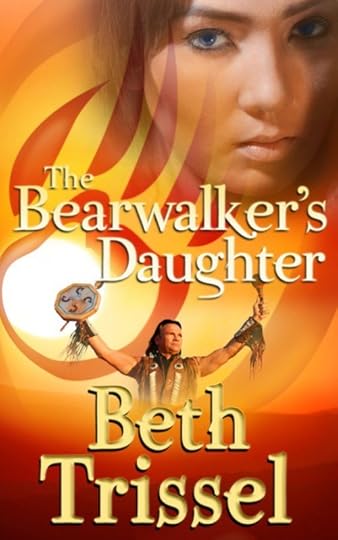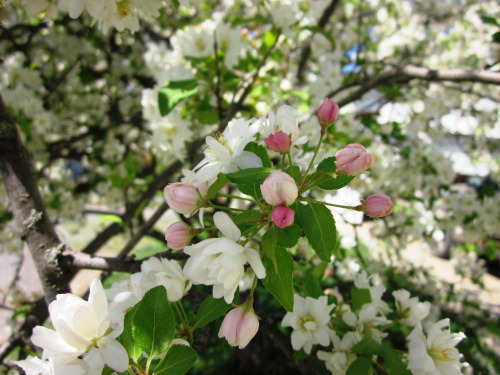Beth Trissel's Blog, page 39
May 28, 2014
When the going gets tough, the tough get kittens
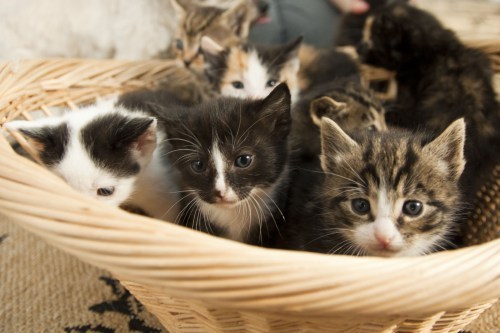 So, this sweet tortoiseshell kitty was dropped off on us, as often happens when living on a farm, and last month she had six kittens. Then, she adopted the two tiny orphans brought to us by my daughter-in-law. That makes eight. I have what we call ‘kitten corner’ on the sun space where people love to gather and watch the kittens play and play with them in turn. It’s a happy spot. Our tiny pom-poo, Sadie, is kitten mad. Our rescue dog, Jilly, doesn’t care about them either way. She was told firmly on her introduction here not to chase cats, and she doesn’t see what else of interest is to be done with them.
So, this sweet tortoiseshell kitty was dropped off on us, as often happens when living on a farm, and last month she had six kittens. Then, she adopted the two tiny orphans brought to us by my daughter-in-law. That makes eight. I have what we call ‘kitten corner’ on the sun space where people love to gather and watch the kittens play and play with them in turn. It’s a happy spot. Our tiny pom-poo, Sadie, is kitten mad. Our rescue dog, Jilly, doesn’t care about them either way. She was told firmly on her introduction here not to chase cats, and she doesn’t see what else of interest is to be done with them.
 Sadie will really miss these little guys when they’re gone. So will I. Meanwhile, I’m doing my best to take care of the brood, along with the help of the very able mama kitty. I’ve decided to call her Miss Kitty. Don’t tell my DH, but she’s staying. Miss Kitty is such a quiet little cat he may not notice. She’s also quite pretty. It is my wild and crazy hope that maybe on down the road I can breed her to the gorgeous Siamese male who has taken up residence on our farm, and she will have amazing kittens. But I haven’t worked out the details yet, given that he’s on the wild side. I’m also thinking it’s possible I may create a new breed, or she may birth my long awaited orange and blue kitten. It’s possible I’m also kitten mad.
Sadie will really miss these little guys when they’re gone. So will I. Meanwhile, I’m doing my best to take care of the brood, along with the help of the very able mama kitty. I’ve decided to call her Miss Kitty. Don’t tell my DH, but she’s staying. Miss Kitty is such a quiet little cat he may not notice. She’s also quite pretty. It is my wild and crazy hope that maybe on down the road I can breed her to the gorgeous Siamese male who has taken up residence on our farm, and she will have amazing kittens. But I haven’t worked out the details yet, given that he’s on the wild side. I’m also thinking it’s possible I may create a new breed, or she may birth my long awaited orange and blue kitten. It’s possible I’m also kitten mad.
“You can’t help that. We’re all mad here.” - The Cheshire Cat from Alice in Wonderland
“You can keep a dog; but it is the cat who keeps people, because cats find humans useful domestic animals.”-George Mikes
As every cat owner knows, nobody owns a cat. - Ellen Perry Berkeley
But we can try.
**Sadie with the kittens. Images by daughter Elise.
Filed under: Uncategorized Tagged: cat quotes, cats, joy of cats, kittens, pom-poo, raising kittens, Siamese, tortoiseshell


May 26, 2014
Rosemary, the Herb of Remembrance
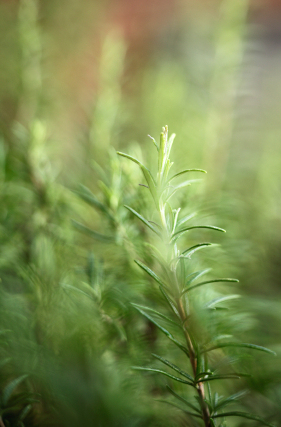 “There’s rosemary that’s for remembrance. Pray, you love, remember.” ~ Hamlet
“There’s rosemary that’s for remembrance. Pray, you love, remember.” ~ Hamlet
Rosemary is the herb that we leave on graves and a fitting one for Memorial Day. I love the scent of rosemary and the wealth of history behind it. Known as the herb of remembrance from the time of ancient Greece, it appears in that immoral verse by Shakespeare. My fascination with herbs plays a significant role in my historical-light paranormal romance novel Somewhere My Love, as does Hamlet, for that matter. I always wanted to write a murder mystery with a focus on herbs and parallels to a Shakespearean play, and so I did. Ghostly, murder mystery, time travel romance novel, Somewhere My Love, is interwoven with Hamlet and herbs.
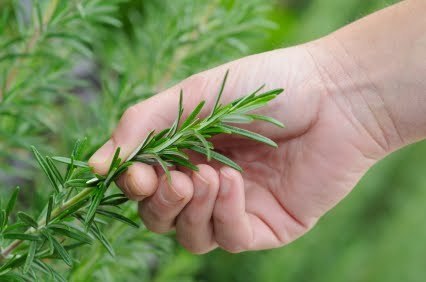 Rosemary is considered a tonic, astringent, diaphoretic (increases perspiration), stimulant. Oil of Rosemary has the carminative (induces the expulsion of gas) properties of other volatile oils and is an excellent stomachic and nervine (has a beneficial effect upon the nervous system), curing many cases of headache.
Rosemary is considered a tonic, astringent, diaphoretic (increases perspiration), stimulant. Oil of Rosemary has the carminative (induces the expulsion of gas) properties of other volatile oils and is an excellent stomachic and nervine (has a beneficial effect upon the nervous system), curing many cases of headache.
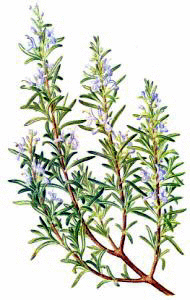 Beloved by the ancients, rosemary had the reputation for strengthening memory. On this account, it became the emblem of fidelity for lovers. And holds a special position among herbs from the symbolism attached to it. Not only was rosemary used at weddings, but also at funerals, for decking churches and banqueting halls at festivals, as incense in religious ceremonies, and in magical spells. It was entwined in the wreaths worn by brides, being first dipped into scented water. Anne of Cleves, fourth wife of Henry VIII, and fortunate to escape with her life due to an annulment, is said to have worn such a wreath at her wedding. Maybe it protected her. She outlived his other wives, two of whom were beheaded, and the sixth one, Catherine Parr, might have been had he hung on much longer. Such were the vagaries of his moods. But I digress.
Beloved by the ancients, rosemary had the reputation for strengthening memory. On this account, it became the emblem of fidelity for lovers. And holds a special position among herbs from the symbolism attached to it. Not only was rosemary used at weddings, but also at funerals, for decking churches and banqueting halls at festivals, as incense in religious ceremonies, and in magical spells. It was entwined in the wreaths worn by brides, being first dipped into scented water. Anne of Cleves, fourth wife of Henry VIII, and fortunate to escape with her life due to an annulment, is said to have worn such a wreath at her wedding. Maybe it protected her. She outlived his other wives, two of whom were beheaded, and the sixth one, Catherine Parr, might have been had he hung on much longer. Such were the vagaries of his moods. But I digress.
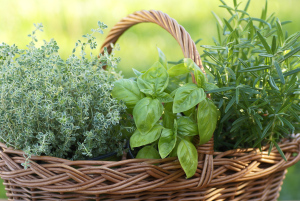 A rosemary branch, richly decorated and tied with ribbons, was also presented to wedding guests, as a symbol of love and loyalty. Rosemary was one of the cordial herbs used to flavor ale and wine. It was also used in Christmas decoration. Together with an orange stuck with cloves it was given as a New Year‘s gift. Rosemary came to represent the dominant influence of the lady of the house, “Where Rosemary flourished, the woman ruled.” I add, to prove their dominance, some husbands would damage the flourishing plants. (A Modern Herbal)
A rosemary branch, richly decorated and tied with ribbons, was also presented to wedding guests, as a symbol of love and loyalty. Rosemary was one of the cordial herbs used to flavor ale and wine. It was also used in Christmas decoration. Together with an orange stuck with cloves it was given as a New Year‘s gift. Rosemary came to represent the dominant influence of the lady of the house, “Where Rosemary flourished, the woman ruled.” I add, to prove their dominance, some husbands would damage the flourishing plants. (A Modern Herbal)
“As for rosmarine, I lette it runne all over my garden walls, not onlie because my bees love it, but because it is the herb sacred to remembrance, and, therefore to friendship..” ~Thomas Moore
Filed under: Uncategorized Tagged: alternative medicine, herbal cures, herbal lore, Historical Romance, paranormal romance, Rosemary, Shakespeare


May 22, 2014
Pokeroot (The Cancer Root)
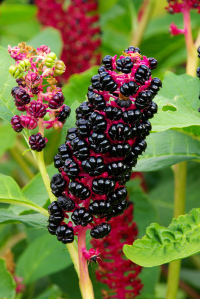 Some of poke’s many names are: Red Ink Plant, Virginia Poke, and Ink Berry. The ripe, deeply purple to reddish-purple berries are among the very first natural inks of the new world. So enduring is ink made from pokeroot berries that it is still to be seen in museums. The berries also produce multitudes of black seeds which the birds love and are said to become intoxicated from eating. I haven’t really noticed any birds on a ‘pokeberry high,’ odd considering the vigorous stands of poke growing here and there. Maybe I’m not paying proper attention, or just think that’s how birds are. Come to think of it, we do have extremely euphoric birds in late summer.
Some of poke’s many names are: Red Ink Plant, Virginia Poke, and Ink Berry. The ripe, deeply purple to reddish-purple berries are among the very first natural inks of the new world. So enduring is ink made from pokeroot berries that it is still to be seen in museums. The berries also produce multitudes of black seeds which the birds love and are said to become intoxicated from eating. I haven’t really noticed any birds on a ‘pokeberry high,’ odd considering the vigorous stands of poke growing here and there. Maybe I’m not paying proper attention, or just think that’s how birds are. Come to think of it, we do have extremely euphoric birds in late summer.
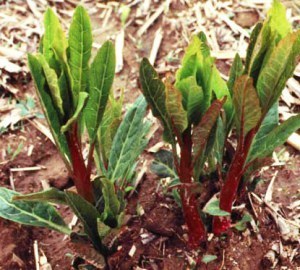 As to the edible shoots, these fat young sprouts grow beside the withered remains of the former season’s plants, the only part that’s not potentially poisonous. Tender shoots gathered in the spring were so popular that they were carried back to Europe by early explorers and proclaimed delicious. The mature and then poisonous stalks take on a purplish hue in place of the appealing green of the younger plants. *Warning, when poke shoots change from green to that deeper reddish-purple color, they’re no longer edible.
As to the edible shoots, these fat young sprouts grow beside the withered remains of the former season’s plants, the only part that’s not potentially poisonous. Tender shoots gathered in the spring were so popular that they were carried back to Europe by early explorers and proclaimed delicious. The mature and then poisonous stalks take on a purplish hue in place of the appealing green of the younger plants. *Warning, when poke shoots change from green to that deeper reddish-purple color, they’re no longer edible.
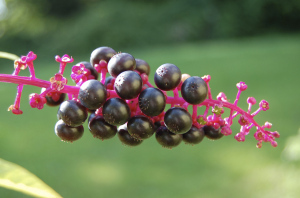 Medicinal uses: The large poisonous roots were collected and dried in the fall. Indians and colonists cut the dried root into pieces and steeped a level tablespoonful of the root in two cups of boiling water, then drained the liquid and dosed themselves sparingly by the spoonful. In small doses, it stimulates the glandular network by acting similarly to cortisone. Poke was believed to be the most effective drug that could favorably alter the course of an ailment, having the power to stimulate the body to heal, assuming the patient wasn’t overdosed. It can also make you quite sick and even prove fatal. One of those ‘Oops, guess that was too much,’ treatments. Tea was also brewed from the ripe berries, and used sparingly. Poultices and salves made from the roots and berries were more safely applied than imbibing the tea. Good old pokeroot salve.
Medicinal uses: The large poisonous roots were collected and dried in the fall. Indians and colonists cut the dried root into pieces and steeped a level tablespoonful of the root in two cups of boiling water, then drained the liquid and dosed themselves sparingly by the spoonful. In small doses, it stimulates the glandular network by acting similarly to cortisone. Poke was believed to be the most effective drug that could favorably alter the course of an ailment, having the power to stimulate the body to heal, assuming the patient wasn’t overdosed. It can also make you quite sick and even prove fatal. One of those ‘Oops, guess that was too much,’ treatments. Tea was also brewed from the ripe berries, and used sparingly. Poultices and salves made from the roots and berries were more safely applied than imbibing the tea. Good old pokeroot salve.
***Pokeroot is also known as the cancer root and has some amazing possibilities in treating various cancers. For more visit this fascinating link: http://www.quantumagriculture.com/node/203
Filed under: Uncategorized Tagged: herbal cures, herbal lore, Native American, natural medicine, pokeroot


May 20, 2014
Haunting Romance Novel Somewhere My Love .99 Thru May
 A Night Owl Top Pick: “The story will draw a reader in and will not let go until the very last page. It is a novel that will live in the hearts of its readers for a very long time.”
A Night Owl Top Pick: “The story will draw a reader in and will not let go until the very last page. It is a novel that will live in the hearts of its readers for a very long time.”Volumes and volumes of books have been written about the ghosts of Virginia. Apparently, we have more ghost stories than any other state in the Union. And not because Virginians have a more fertile imagination (although we may) but sadly because the Old Dominion has seen more bloody battles over the centuries than any other. Before you differ with me, think back.
Jamestown (founded 1607) was the site of the oldest successful English settlement and its history is a violent one. It’s also kind of creepy. And on we go to the many heart-rending wars fought with the usurped Indians, a number of them waged on Virginia soil. Virginia used to be a lot bigger than it is now, too. It spanned states.
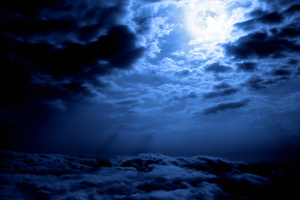 And on we march to the Revolution. Anyone heard of Yorktown, to name just one famous battle? And let’s not forget that horrific most uncivil of wars, much of it fought in, you guessed it, Virginia. My ancestors took part in these wars, with the possible exception of James Town, although I’m thinking we came across a family account somewhere. Need to check.
And on we march to the Revolution. Anyone heard of Yorktown, to name just one famous battle? And let’s not forget that horrific most uncivil of wars, much of it fought in, you guessed it, Virginia. My ancestors took part in these wars, with the possible exception of James Town, although I’m thinking we came across a family account somewhere. Need to check. Back to the ghosts: This plethora of paranormal activity doesn’t only feature soldiers caught in an endless fray who haven’t gotten word the war’s over–although some clairvoyant really should make the rounds of old battle fields and direct these poor souls to the light. Many tales center on the myriad of people who dwelt in our richly historic state. The old Virginia homes and plantations have accumulated a wealth of such stories. It was while touring some of these English styled manor homes with my dear mother that the kernel of a story first came to me for
Somewhere My Love (Somewhere in Time Series)
.
Back to the ghosts: This plethora of paranormal activity doesn’t only feature soldiers caught in an endless fray who haven’t gotten word the war’s over–although some clairvoyant really should make the rounds of old battle fields and direct these poor souls to the light. Many tales center on the myriad of people who dwelt in our richly historic state. The old Virginia homes and plantations have accumulated a wealth of such stories. It was while touring some of these English styled manor homes with my dear mother that the kernel of a story first came to me for
Somewhere My Love (Somewhere in Time Series)
. Added to this meld of vintage Virginia is my own heritage. On my father’s side, I descend from old Southern gentry, impoverished after the Civil War, Great Depression, and other misfortunes, including the untimely death of my brilliant grandfather. But the gracious Georgian home his ancestor built (circa 1816) still stands in the countryside near historic Staunton. My ghostly Christmas novella, Somewhere the Bells Ring (Somewhere in Time Series), was inspired by this wonderful old home.
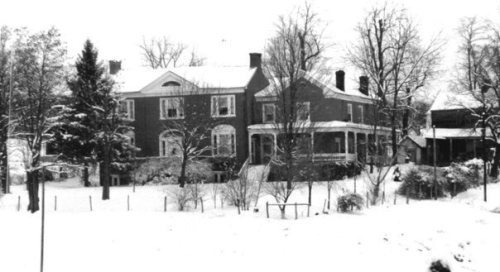
Since childhood, I felt the family home place was haunted and wove stories through my fevered mind, along with my continual search for Narnia which entailed frequent treks into the old wardrobe. But I digress. Frequently. The magnificent ancestral portraits in my family and on display in other Virginia homes held me transfixed, wondering. And it was just such a portrait of a striking dark-haired gentleman who embedded himself in my thoughts. Who was he? Why did he die so young? That other painting of the fair young lady…did she love him?
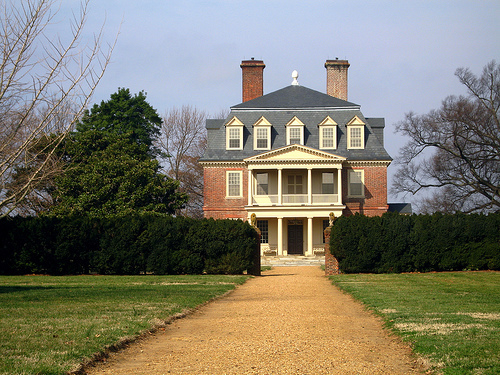 Often, the guides at these old homes are brimming with tales. But other times we are left to wonder…and ask ourselves are these folk who’ve gone before us truly gone, or do some still have unfinished business in this realm? And what of the young lovers whose time was tragically cut short, do they somehow find a way? Love conquers all, and so I answer ‘yes.’
Often, the guides at these old homes are brimming with tales. But other times we are left to wonder…and ask ourselves are these folk who’ve gone before us truly gone, or do some still have unfinished business in this realm? And what of the young lovers whose time was tragically cut short, do they somehow find a way? Love conquers all, and so I answer ‘yes.’ Blurb For Somewhere My Love
:
Blurb For Somewhere My Love
:Fated lovers have a rare chance to reclaim the love cruelly denied them in the past, but can they grasp this brief window in time before it’s too late?
Two hundred years ago Captain Cole Wentworth, the master of an elegant Virginian home, was murdered in his chamber where his portrait still hangs. Presently the estate is a family owned museum run by Will Wentworth, a man so uncannily identical to his ancestor that spirit-sensitive tour guide Julia Morrow has trouble recognizing Cole and Will as separate. As Julia begins to remember the events of Cole’s death, she must convince Will that history is repeating, and this time he has the starring role in the tragedy. The blade is about to fall.~
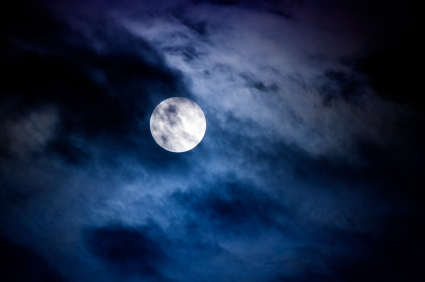
“As I read Somewhere My Love, I recalled the feelings I experienced the first time I read Daphne DuMaurier’s Rebecca long ago. Using the same deliciously eerie elements similar to that Gothic romance, Beth Trissel has captured the haunting dangers, thrilling suspense and innocent passions that evoke the same tingly anticipation and heartfelt romance I so enjoyed then, and still do now.”~joysann for Publisher’s Weekly

***Somewhere My Love is available in kindle and print at Amazon and Barnes & Noble and in eBook at Kobo.
*Homes most prominent behind the inspiration for Somewhere My Love:
Berkely Plantation (On the James River & well worth a visit)
Family home place called Chapel Hill (Not open to the public)
Shirley Plantation (On the James River & well worth a visit)
Filed under: Uncategorized Tagged: .99 kindle, award winning romance, ghost story, ghostly, haunting, Historical romance novel, James River, murder mystery, Paranormal, Shirley Plantation, Thriller, Time travel romance, Virginia


May 14, 2014
How Long Have Folks Had Cottage Gardens?
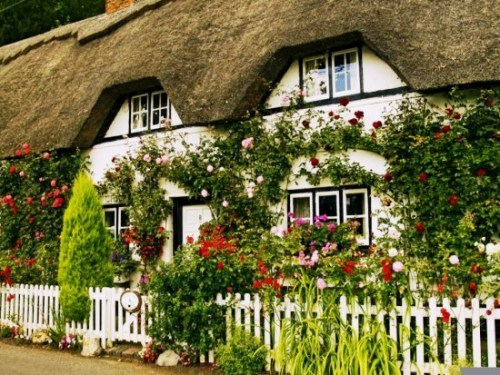 For eons. Cottage gardens stretch back hundreds of years to the time when people used herbs for everything and grew most of their own food. These gardens acquired their name from the country cottage around which they grew. I love cottage gardens best of all and strive to have my own. However, there are drawbacks. I live in a boxy white farm house, not a cottage, and our yard and gardens are rather sprawling for that overflowing, filled to the brim, in a compact sort of way look. Like mine, these small gardens are (and were) a mix of flowers, vegetables, and herbs. I strongly associate cottage gardens with the British Isles, because of our shared history and the influence of the Mother Country on the New World. But other countries have them too.
For eons. Cottage gardens stretch back hundreds of years to the time when people used herbs for everything and grew most of their own food. These gardens acquired their name from the country cottage around which they grew. I love cottage gardens best of all and strive to have my own. However, there are drawbacks. I live in a boxy white farm house, not a cottage, and our yard and gardens are rather sprawling for that overflowing, filled to the brim, in a compact sort of way look. Like mine, these small gardens are (and were) a mix of flowers, vegetables, and herbs. I strongly associate cottage gardens with the British Isles, because of our shared history and the influence of the Mother Country on the New World. But other countries have them too.
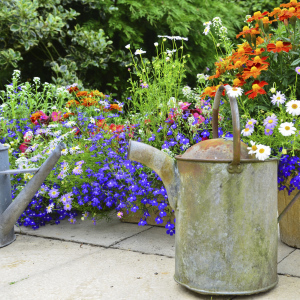 People acquired the plants for their cottage gardens from friends and family in the form of ‘starts’ (root divisions) cuttings, and seeds. Very much as I do today, only I have the added benefit of seed catalogs. They are called passalong plants. Sometimes these gifts of plant starts to others have come back to me when my own died out. Thank heavens, I’m generous. :)
People acquired the plants for their cottage gardens from friends and family in the form of ‘starts’ (root divisions) cuttings, and seeds. Very much as I do today, only I have the added benefit of seed catalogs. They are called passalong plants. Sometimes these gifts of plant starts to others have come back to me when my own died out. Thank heavens, I’m generous. :)
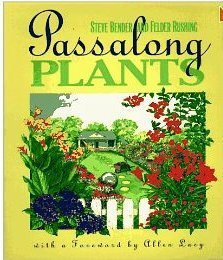 Back to the garden, encourage beneficial insects to make their home among the plants and experiment with companion planting. Avoid monochromatic schemes and think variety. And remember the old-time, non hybrid varieties of flowers and vegetables. A great book about growing heirloom plants and sharing them with others is Passalong Plants. A delightful read chocked full of information. And Happy gardening!
Back to the garden, encourage beneficial insects to make their home among the plants and experiment with companion planting. Avoid monochromatic schemes and think variety. And remember the old-time, non hybrid varieties of flowers and vegetables. A great book about growing heirloom plants and sharing them with others is Passalong Plants. A delightful read chocked full of information. And Happy gardening!
Filed under: Uncategorized Tagged: cottage garden, Gardening, growing herbs and heirloom flowers, the British Isles, The Shenandoah Valley, Virginia


May 12, 2014
Historical Fantasy Romance, The Bearwalker’s Daughter, Only .99 Thru May 18th
Normally 2.99, The Bearwalker’s Daughter is on sale for .99 in KINDLE!
A Handsome frontiersman, Mysterious Scots-Irish Woman, Bearwalking Shawnee Warrior, Dark Secret, Pulsing Romance…The Bearwalker’s Daughter
The strange awareness inside Karin grew, like a summons urging her to an untamed place. His gaze drew her almost against her will. She leaned toward him.
“Someone seeks you, Shequenor’s dahnaithah.”
The message rippled through her. And she knew—his was the inviting summons in the wind.~
Karin McNeal hasn’t grasped who she really is or her fierce birthright. A tragic secret from the past haunts the young Scots-Irish woman longing to learn more of her mother’s death and the mysterious father no one will name. The elusive voices she hears in the wind hint at the dramatic changes soon to unfold in the mist-shrouded Alleghenies in Autumn, 1784.
Jack McCray, the wounded stranger who staggers through the door on the eve of her twentieth birthday and anniversary of her mother’s death, holds the key to unlock the past. Will Karin let this handsome frontiersman lead her to the truth and into his arms, or seek the shelter of her fiercely possessive kinsmen? Is it only her imagination or does someone, or something, wait beyond the brooding ridges—for her?
***The Bearwalker’s Daughter is Book I in my Native American Warrior Series. The novel has 69 customer reviews and 4.4 stars at Amazon.
“Ms. Trissel’s alluring style of writing invites the reader into a world of fantasy and makes it so believable it is spellbinding.” ~Long and Short Reviews
***Cover by my talented daughter Elise
Filed under: Uncategorized Tagged: .99 kindle romance, adventure romance, historical fantasy, Historical Romance, Native American Romance, paranormal romance, Scotch-Irish American, western romance


May 8, 2014
Sage In America and the Native American Smudging Ceremony
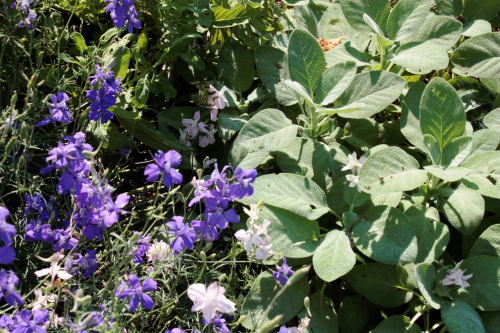
Sage is a lovely and important medicinal herb, also a sacred one. I grow several varieties and am always adding more. My garden is never without the traditional garden sage, salvia officinalis. There are some variations of this kind, the fuzzy leafed and tricolored sage, but I still like the good old standby that came to America with the early colonists. You may not realize how many varieties of sage are native to the New World, and their many uses, medical and spiritual. Scarlet sage attracts hummingbirds and is striking in the border, but there are many beautiful varieties. (*Sage and larkspur in our garden. Image by Elise)
Sage (Salvia) Common name: Wild Sage, Meadow Sage (S. pratensis) Scarlet Sage or Texas Sage (Salvia coccinea), Chia Sage grows throughout southern Canada and the United States, the very important chia (S. columbriae) in Arizona, Utah, Nevada, and California.
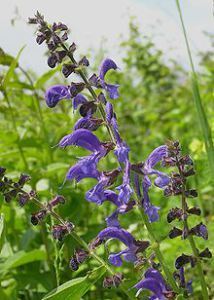
From Field Guide to Medicinal Wild Plants by Bradford Angier:
I love this book, given to me by my dear grandmother who lived to be 99 and a half. Mr. Angier has also written other volumes.
Sage is a fuzzy perennial with soft, downy hairs. One characteristic is that, when a bunch is wadded together, it clings to itself, remaining a compact mass. The erect stems are greyish with down and have, on pubescent stalks toward their bases, up to about 18-inch-long leaves.
Several wheels of tiny blue or whitish, and sometimes reddish, flowers grow in whorls of four to eight, depending on the particular species. The plants have an easily recognized strong, unique, aromatic odor.
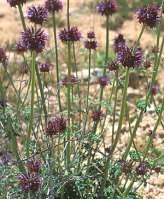 The chia variety, a distinctive annual springing up in the Southwest at the start of the late fall rains and an Indian standby, is a rough sage with deeply incised, coarse, usually hairy, dark-green leaves that grow mostly close to the ground. Three or so whirls of small blue flowers circle, mint like, in separated densities above prickly, dark-red, leafy bracts. These mature into seed-filled pods that remain like skeletons when the rest of the plant has withered, not giving the winds enough purchase to blow them free, and leaving them for the Indians to gather.
The chia variety, a distinctive annual springing up in the Southwest at the start of the late fall rains and an Indian standby, is a rough sage with deeply incised, coarse, usually hairy, dark-green leaves that grow mostly close to the ground. Three or so whirls of small blue flowers circle, mint like, in separated densities above prickly, dark-red, leafy bracts. These mature into seed-filled pods that remain like skeletons when the rest of the plant has withered, not giving the winds enough purchase to blow them free, and leaving them for the Indians to gather.The seeds of the Texas sage (S. coccinea) are oblong, angular, or bowed, and 2 to 3 millimeters in size. Those of the annual scarlet sage take two or three weeks to emerge.
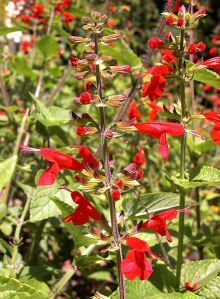 The medicinal part of the plant in general is the leaves, harvested during the flowering period in June and July. In the case of the chia, the vital part is the seeds, which are gathered from the then nearly dead annual in July.
The medicinal part of the plant in general is the leaves, harvested during the flowering period in June and July. In the case of the chia, the vital part is the seeds, which are gathered from the then nearly dead annual in July.Steeped like tea and in the same proportions, sage tea was slightly tonic and quieting to a disordered stomach. It’s peculiar but pleasant odor was retained in the beverage by the warmish, somewhat bitter aroma of the extracted volatile oil. It was said to benefit a ticklish and irritated throat, to quiet and expel bothersome gas, and assist the liver, kidneys, and gallbladder. Regarded in many regions as effective in treating sore throat, accompanied by fever, cankers, sore gums, mouth ulcers, and swollen tonsils, and as an effective gargle. The juice from bruised fresh leaves was credited with helping to remove warts, also pressed into service for sores, cuts, and wounds. The Indians made a salve of the crushed fresh leaves and edible lard for these purposes. Some tribes made salve from the roots of wild sage (S. lyrata).
A refreshing drink for hot weather was made by mixing chia seeds with cool water, each seed becoming separately suspended in its own white, mucilaginous cloudiness. The white, gray, and brown seeds are so nutritious that a teaspoonful was regarded as enough to sustain an Indian for a day on a forced journey.
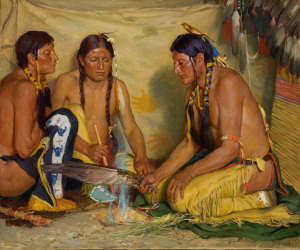 Native American Smudging Ceremony: From The Smudging Ceremony
Native American Smudging Ceremony: From The Smudging Ceremony“Our Native elders have taught us that before a person can be healed or heal another, one must be cleansed of any bad feelings, negative thoughts, bad spirits or negative energy – cleansed both physically and spiritually.,,Native people throughout the world use herbs to accomplish this. One common ceremony is to burn certain herbs, take the smoke in one’s hands and rub or brush it over the body. Today this is commonly called “smudging.” In Western North America the three plants most frequently used in smudging are sage, cedar, and sweetgrass.
Many varieties of sage have been used in smudging. The botanical name for “true” sage is Salvia (e.g. Salvia officinalis, Garden Sage, or Salvia apiana, White Sage). It is interesting to note that Salvia comes from the Latin root salvare, which means “to heal.” There are also varieties of sage which are of a species separate from Salvin Artemusia. Included here are sagebrush (e.g. Artemisia californica) and mugwort (Artemisia vulgaris). We have seen both Salvia and Artemisia sub-species used in smudging.”
I’ve covered salvia officinalis (pictured below) in another post, but briefly: Salvia officinalis (called garden or common sage) is a perennial, evergreen subshrub, with woody stems, grayish leaves, and blue to purplish flowers. A member of the family Lamiaceae, sage is native to the Mediterranean region, though it has naturalized in many places throughout the world.
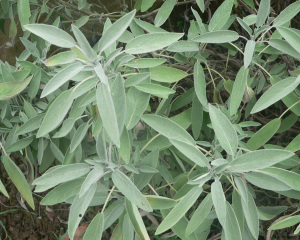 From How to Perform A Native American Smudging Ceremony:
From How to Perform A Native American Smudging Ceremony:“Native Americans consider sage, cedar, sweetgrass and tobacco as the Four Sacred Herbs. Sage is found across North America, with white sage being the most potent and gray sage found in many northern areas where the gray will not over-winter. Cedar (Eastern red cedar) (Eastern white cedar) and sweetgrass also are indigenous to this continent. Tobacco can be found in many forms; however for this ceremony Nicotiana Rustica, or a similar dried tobacco leaf, native to America is preferred.”
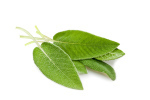
Filed under: Uncategorized Tagged: herbal lore, Lamiaceae, medicinal herb, medicinal uses of sage, NA smudging ceremony, Native American, sage, Salvia, Salvia apiana, Salvia officinalis, smudging ceremony, Texas Sage, United States


May 7, 2014
The Healing Powers of the Willow Tree
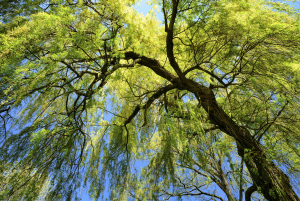 I love weeping willows, especially in the spring with their graceful branches draped in soft green, but there’s far more to this tree than beauty. The willow is considered “one of Nature’s most valuable gifts to mankind,” says Bradford Angier in Field Guide to Medicinal Wild Plants. As mentioned earlier, willow contains salicylic acid, the same component as aspirin. According to Mr. Angier, “The North American Indians soon discovered that tea decocted and steeped from the cambium of the majority of willows was important for arthritis and for reducing fever and many pains—this centuries before the isolating and marketing of aspirin. The ashes of burned willow twigs were blended with water and used for gonorrhea. Willow roots were powdered with stones and turned to in an effort to dry up sores from syphilis. The settlers soon joined the Indians in using potent teas brewed from the cambium or inner bark of the bitter willows to treat venereal disease.
I love weeping willows, especially in the spring with their graceful branches draped in soft green, but there’s far more to this tree than beauty. The willow is considered “one of Nature’s most valuable gifts to mankind,” says Bradford Angier in Field Guide to Medicinal Wild Plants. As mentioned earlier, willow contains salicylic acid, the same component as aspirin. According to Mr. Angier, “The North American Indians soon discovered that tea decocted and steeped from the cambium of the majority of willows was important for arthritis and for reducing fever and many pains—this centuries before the isolating and marketing of aspirin. The ashes of burned willow twigs were blended with water and used for gonorrhea. Willow roots were powdered with stones and turned to in an effort to dry up sores from syphilis. The settlers soon joined the Indians in using potent teas brewed from the cambium or inner bark of the bitter willows to treat venereal disease.
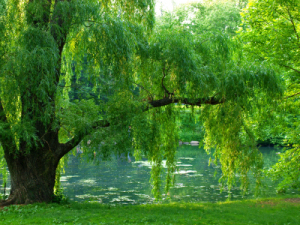 The dried and powdered bitter bark, astringent and detergent, was applied to the navels of newborn babies. It was utilized to stop severe bleeding, as were the crushed young green leaves, the bark, and the seeds, also stuffed up the nostrils to stop nosebleeds. These were also used for toothache.”
The dried and powdered bitter bark, astringent and detergent, was applied to the navels of newborn babies. It was utilized to stop severe bleeding, as were the crushed young green leaves, the bark, and the seeds, also stuffed up the nostrils to stop nosebleeds. These were also used for toothache.”
And the uses go on, including a spring tonic made of steeped willow roots, an Indian practice adopted by the settlers. The roots were used to kill and expel worms and willow tea to bathe sore eyes. Some settlers also shared in the Indian practice of using pussy willow catkins as an aphrodisiac. Probably in the form of a bark tea, but it doesn’t say.
 Pussy willows are also a favorite of mine, but just because. Spring wouldn’t be spring without their fuzzy catkins.
Pussy willows are also a favorite of mine, but just because. Spring wouldn’t be spring without their fuzzy catkins.
THE WILLOW CATS
~Margaret Widdemer
They call them pussy-willows,
But there’s no cat to see
Except the little furry toes
That stick out on the tree:
I think that very long ago,
When I was just born new,
There must have been whole pussy-cats
Where just the toes stick through—-
And every Spring it worries me,
I cannot ever find
Those willow-cats that ran away
And left their toes behind!
Filed under: Uncategorized Tagged: alternative medicine, herbal lore, herbal medicine, Native American, weeping willow, willow tree


May 5, 2014
Old Herbal Treatments–Boneset
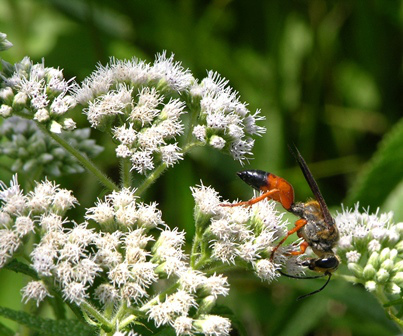 Boneset (Ague-weed) is a beautiful native plant found in moist meadows, woodlands, along stream banks, or in swamps across Eastern North America and west to Louisiana and Minnesota. A member of the aster family, it blooms July–September with flat clusters of white flowers. Once established, boneset resembles a small shrub at 3’ to 4’ tall. The base of the leaves appear to wrap around the stem, as if pierced by the stem. This perforated arrangement of the leaf and stem led to the species name E. perfoliatum. Because the leaves are wrapped around the stem, early herbalists concluded the plant would be useful as a plaster, along with bandages, for setting broken bones. Boneset was also infused as a tea to treat fevers, colds, and digestive ailments. A Modern Herbal suggests the name boneset rose from its use as a treatment for Dengue fever, also known as Break Bone Fever, and declares, ‘Probably no plant in American domestic practice has had more extensive and frequent use.’ The summer flowers attract pollinating insects, such as butterflies. In the fall, the seeds draw a variety of songbirds.
Boneset (Ague-weed) is a beautiful native plant found in moist meadows, woodlands, along stream banks, or in swamps across Eastern North America and west to Louisiana and Minnesota. A member of the aster family, it blooms July–September with flat clusters of white flowers. Once established, boneset resembles a small shrub at 3’ to 4’ tall. The base of the leaves appear to wrap around the stem, as if pierced by the stem. This perforated arrangement of the leaf and stem led to the species name E. perfoliatum. Because the leaves are wrapped around the stem, early herbalists concluded the plant would be useful as a plaster, along with bandages, for setting broken bones. Boneset was also infused as a tea to treat fevers, colds, and digestive ailments. A Modern Herbal suggests the name boneset rose from its use as a treatment for Dengue fever, also known as Break Bone Fever, and declares, ‘Probably no plant in American domestic practice has had more extensive and frequent use.’ The summer flowers attract pollinating insects, such as butterflies. In the fall, the seeds draw a variety of songbirds.
From http://medicinalherbinfo.org/herbs/Boneset.html:
“Boneset was one of early America’s foremost medical plants, a popular panacea of extraordinary powers. Native Americans introduced the settlers to this New World herb. Its name reflects its use during a particularly harsh strain of flu called “break bone fever”. Come cold and flu season, boneset can be invaluable in relieving coughs and upper respiratory congestion. Today, it is chiefly regarded as a weed with an interesting past.”
From another interesting site:http://www.alchemy-works.com/eupatorium_perfoliatum.html
“In West Virginia folk medicine, boneset was simmered with lemon and honey to make a cough syrup. The Eclectic physicians used it with success during the influenza epidemic of 1918-19. In modern herbalism, it is usually combined with elder and willow for fevers with aches, and with scullcap and milkweed for flu.”
Filed under: Uncategorized Tagged: boneset, herbal lore, herbal medicine, Herbs, Native American herb


May 1, 2014
Bringing in the May
As a child growing up during the 19th century, or so it sometimes seems, I remember placing baskets of flowers as a surprise on friend’s doorstep early on a lovely May Day morn. Also, dancing around the May Poll festivities in which, not I, but my younger brother and sister both participated. The little girls with garlands in their hair, decked out in pretty spring dresses. Mom made my sister’s. One year the wind toppled the May Poll and then there’s the time the children got all wound up in the ribbons and over it went. Humiliating for my young brother who’d practiced so hard and tried to no avail to instruct his fellow dancers to wind them properly. I never did trust that May Poll thing to go as planned and hoped to be crowned May Queen, surrounded by a glad assembly of courtiers. No such luck. But May Day was special and has strong flowery associations in my memory. And wind. It never entered anyone’s mind that this revelry had possible pagan connotations. May Day festivities were simply a spring rite and good fun. (*Image of flowering crab apple tree in our yard)
How about the rest of you? Any May Queens among us?
More on May Day from: http://www.infoplease.com/spot/mayday.html
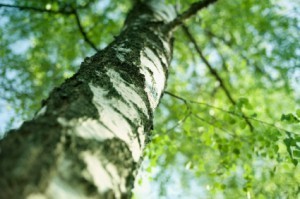 “May 1st, often called May Day, just might have more holidays than any other day of the year. It’s a celebration of Spring. It’s a day of political protests. It’s a neopagan festival, a saint’s feast day, and a day for organized labor. In many countries, it is a national holiday. (Royalty free image of birch tree)
“May 1st, often called May Day, just might have more holidays than any other day of the year. It’s a celebration of Spring. It’s a day of political protests. It’s a neopagan festival, a saint’s feast day, and a day for organized labor. In many countries, it is a national holiday. (Royalty free image of birch tree)
Beltane
A Celtic calendar feast ushering in the start of summer. (It also went by a variety of other spellings and names in assorted dialects of Gaelic.)
Bonfires, often created by rubbing sticks together, were common features of Beltane celebrations. Related rituals included driving cattle between two fires, dancing around the fires, and burning witches in effigy. Another tradition was Beltane cakes, which would be broken into several pieces, one of which was blackened. They would be drawn by celebrants at random; the person getting the unlucky blackened piece would face a mock execution.
In recent years, Beltaine has been adopted or revived by neopagan groups as a major seasonal festival.
Bringing in the May: *This is more what I remember. :)
In medieval England, people celebrated the start of spring by going out to the country or woods “going a-maying” and gathering greenery and flowers, or “bringing in the may.” This was described in “The Court of Love” (often attributed to Chaucer, but not actually written by him) in 1561. Totally irrelevant, but I am a direct descendent of Chaucer on my father’s side.
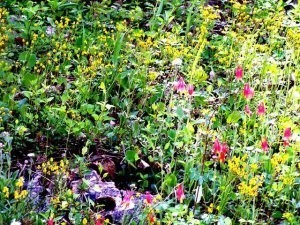 “And furth goth all the Court, both most and lest,
“And furth goth all the Court, both most and lest,
To feche the floures fressh, and braunche and blome;
And namly, hawthorn brought both page and grome.
With fressh garlandes, partie blewe and whyte,
And thaim rejoysen in their greet delyt.”
(*Wild roadside flowers near us)
Another English tradition is the maypole. Some towns had permanent maypoles that would stay up all year; others put up a new one each May. In any event, the pole would be hung with greenery and ribbons, brightly painted, and otherwise decorated, and served as a central point for the festivities.
May Day was also a time for morris dancing and other dances, often around the maypole. In the 19th century, people began to braid the maypole with ribbons by weaving in and out in the course of a dance. Other later traditions include making garlands for children and the crowning of the May Queen.”
From an interesting site: Herbal Musings
“Beltain, Bealtaine, Beltine, May Day, Cetsamhain (‘first Samhain‘), Walpurgis Night (Beltane Eve), Celtic ‘Flower Festival’
Druidic Name: Beltane
 Christian Equivalent
Christian Equivalent
Roodmas, Rood Day, Feast of Saint Philip and Saint James, Feast of Saint Walpurga
Beltane is the cross-quarter festival that marks the start of the summer quarter of the year and the end of the spring quarter. This is a time when nature blossoms and felicity and fertility return to the land. In times past, the livestock stockaded at Samhain was returned to summer pastures at Beltane.
…a joyful festival of growth and fecundity that heralds the arrival of summer. It is the festival of the ‘Good Fire’ or ‘Bel-fire’, named after the solar deity Bel. Bel was also known as Beli or Bile in Ireland, with Bile meaning ‘tree’, so Beltane may also mean ‘Tree-fire’. Beltane is the counterpart of Samhain (and is sometimes referred to as Cetsamhain, the ‘first Samhain’), and these two important festivals divide the year into summer and winter halves, just as the two equinoctial celebrations, Ostara and Mabon, divide the year into light and dark halves.
Lighting fires was customary at Beltane, and traditionally a Beltane fire was composed of the nine sacred woods of the Celts. All hearth fires were extinguished on Beltane Eve and then kindled again from the sacred “need fires” lit on Beltane. People would leap through the smoke and flames of Beltane fires and cattle were driven through them for purification, fertility, prosperity and protection.
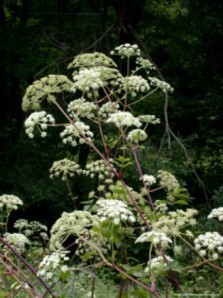 It is a traditional time for Handfastings (marriages), and for couples to make love outside to bless the crops and the earth. Maypoles were often danced around at Beltane to bring fertility and good fortune. Beltane lore also includes washing in May-day dew for beauty and health, and scrying (peeping) in sacred waters, such as ponds or springs.
It is a traditional time for Handfastings (marriages), and for couples to make love outside to bless the crops and the earth. Maypoles were often danced around at Beltane to bring fertility and good fortune. Beltane lore also includes washing in May-day dew for beauty and health, and scrying (peeping) in sacred waters, such as ponds or springs.
The festival is sometimes referred to as Roodmas, a name coined by the medieval Christian Church in an attempt to associate Beltane with the Cross (the Rood) rather than the life-giving symbol of the Maypole. Beltane was also appropriated by the Church as the Feast Day of Saint Walpurga, who was said to protect crops and was often represented with corn.”
(*Royalty free images of the Archangel Michael and the sacred herb Angelica)
Filed under: Uncategorized Tagged: Beltane, Celtic, Celts, herbal lore, Ireland, May Poll, May Queen, May-day, Samhain, Walpurgis Night




